English resume |
Comment |
>Top 1. What is reality? What is magic?:
- Reality is everything that exits.
- How do we know things exist; our five senses do a pretty good job of convincing us that many things are real.
- Models: testing our imagination:
- We imagine what might be there. That is called the model. We then work out what we ought to see, or hear, etc. often with the help of measuring instruments fit the model were true.
- We come to know what is real in one of thee ways:
- detect it directly by our five senses
- detect it indirectly by special instruments such as telescopes and microscopes
- even more indirectly by creating models of what might be real and testing those models to see whether they successfully predict things that can see or hear, etc.
- Magic in three different ways:
- Supernatural magic: we find in myths and fairy tales.
- Stage magic: really does happen, and it can be great fun.
- Poetic magic: 'magical' simply means deeply moving, exhilarating.
- Science takes exactly the opposite approach:
- Science thrives on its inability to explain everything, and goes on asking question, creating possible models and testing them, inch by inch, closer to the truth.
- If something went against our current understanding of reality, scientist require us to abandon or at least change it.
- It is through such adjustments and subsequent testing that we approach closer and closer to what is true.
- Slow magic of evolution:
- Evolution by natural selection: it explains everything we know about life on earth.
|
1. リアリティとは何か。マジックとは:
- リアリティとは存在するすべてのもの
- では我々はどうやってものの存在を知るのか。我々の五感を通じての確信。
- モデル:我々の想像力a
- 我々はそこにあるかも知れないものを想像する。それをモデルという。さらに我々は器具を通じて、そのモデルの真実性を見聞きする。
- 我々は以下の3通りで真実であることを確認する。
- 五感を通じた直接の感知
- 望遠鏡や顕微鏡など特別の道具による間接の感知
- 真実らしいモデルを作成し、それをうまく知覚できるモデルかを検証することでさらに間接的に感知
- 三通りのマジック:
- 超自然マジック:神話や童話
- ステージマジック:舞台でのマジック
- 詩的マジック:深く心を動かされるマジック
- 科学のアプローチ:
- 科学をすべてを説明できないことから発展。モデルを作って検証し、一歩一歩真理に近づく方法
- もし現実と異なれば、その理論はすぐ破棄
- このような調整と検証通じて真実に迫る。
- 進化のスローマジック:
|
>Top 2. Who was the first person?:
- Who was the first person really?
- Find a picture of yourself. Now take a picture of your father and place it on top. Then find a picture of his father, our grandfather...
- It isn't easy to imagine a pile of 185M pictures. (=180 NY skyscrapers height)
- Your 185M-greats-grandfather was a fish, and greats-grandmother is just as well.
- Everything is gradual:
- You are Homo sapiens and your 50,000-greats-grandfather was Homo erectus.
- But there never was a Homo erectus who suddenly gave birth to a Homo sapiens baby.
- Fossils:
- Negative picture of the animal:
if the mud later hardens to become sedimentary rock, the animal7s body may rot away, leaving in the hardening rock a hollow imprint of its form which we eventually find.
- Positive replica:
The hollow imprint may act as a mould into which new sediments fall, later hardening to form a positive replica of the outside of the animal's body.
- Age determination:
by measuring radioactive isotopes in the rocks. So, we have to find igneous rocks close by sedimentary layers and use them as our clocks.; Carbon-14 has a half life of 5730 years.
- DNA finger print:
- DNA is the genetic information that all living creatures carry in each of their cells.
- Counting the number of letter diferences in genes is useful for working out how closely related diffrent species are.
- Distant cousins:
Of the total of 2076 letters in FoxP2, the chimpanzee has 9 letters diffeernt from ours, while the mouse has 139 letters different.
|
2 最初の人間とは:
- 最初の人間は誰か?
- 先祖の写真を次ぎ次ぎと重ねる
- 185M枚の写真(=NY高層ビル180棟分)
- 185百万世代前は魚類だった。
- すべては漸進的:
- 5万世代前の祖父はHomo electus
- 但し、急にHomo sapiensの子供は生まれない。
- 化石:
- ネガティブ画像:
堆積岩になる際に、骨格の内側が固化してできる化石
- ポジティブ画像:
外側の骨格も、結晶によって置換
- 年代測定:
放射性同位体元素の測定による。C14の半減期は5730年
- DNAの指紋:
- DNAは、すべての生物の細胞内にある遺伝情報
- DNAの差異を比較することで親戚関係がわかる
- 遠い従兄弟関係:
FoxP2遺伝子には2076文字ある。内、ヒトとチンパンジーとの差は9箇所、ネズミとは139箇所異なる。
|
>Top 3. Why are there so many different kinds of animals?:
- Number of different kinds of animals:
- There doesn't seem to be any myth that specifically tackles the sheer number of different kinds of animals.
- In 1920s a German scientist Ernst Mayr complied a list of 137 species of birds of the New Guinea highlands; But the local Papuan tribesmen had separate names for 136 of them.
- Scientific name of an animal or plant consists of two Latin words:
- Home sapiens; Homo erectus; Homo habilis
- Panthera leo (lion); Pantera tigris (tiger); Panthera pardus (leopard or panther) and Panthera onca (jaguar);
- Darwin: "On the Origin of Species":
- Tree diagram showing divergence of species.
- Imagine an ancestral species splitting into two species. If each of those then splits into two, that makes four. If you carry on doubling up, it doesn't take long to get up into the millions of species.
- How languages and species divide:
- After enough centuries of drift, different that people in one region can no longer understand people in another. At this point we call them separate languages.
- That is what happen when German and Dutch drifted in separate directions.
- It is what happened when French, Italian, Spanish and Portuguese independently drifted away from Latin in separate parts of Europe.
- Languages can pick up 'loan words' from other languages.
- By contrast, never (or almost never) exchange DNA ever again, once they have drifted far enough apart to have stopped breeding together.
- Bacteria are another story; they do exchange genes.
- Islands and isolation: the power of separation:
- To a frog, an oasis is an 'island' where it can live, surrounded by a desert where it can't.
- To a fish, a lake is an island; the population of an island is cut off from contact with other populations and is free to begin to evolve in its own direction.
- Genes can occasionally cross the barrier surrounding it, whether this be water or uninhabitable land.
- The Galapagos islands:
- inspired Charles Darwin's first thoughts on evolution when, as a member of the expedition of HMS Beagle, he visited them in 1835.
- Most of the Galapagos islands have only a single large volcano, but Isabela have five; each volcano as a kind of island within an island; marine iguanasm, unlike land iguanas, are found nowhere but Galapagos.
- Any kind of isolation by geographical barrier which can be crossed sometimes but not too often leads to evolutionary branching.
- The Great Rift Valley in Africa:
- Humans evolved on the east side and chimpanzees on the west. The barrier in that cae was the Congo river.
- Grancestor (grand ancestor):
- 185M years ago, the shared grancestor of all surviving mammals lived.
- Since then, its descendant have branched and branched, producing
- 231 peceis of carnivores (dogs, cats, weasels, bears, etc.)
- 2000 species of rodents, gnawing animals
- 88 species of whales and dolphins
- 196 species of Artiodactyla, cloven-hoofed animals (cows, antelopes, pigs, deer, sheep)
- 16 species of Perrisodactyla, horse family (horses, zebras, tapirs and rhinos)
- 87 rabits and hares
- 977 species of bats
- 68 species of kangaroos
- 18 species of apes, including humans
- lots of species tha have gone extinct
- Re: EX (extict); EW (extict in the wild); CR (critically endangered; EN (endangered); VU (vulnerable); CD (conservation dependent); NT (near threntened); LC (least concern)
- Stirring, selection and survival:
- gene flow; gene pool
- However different the details, in all species the name of the game is gene survival in gene pools.
|
3. なぜ動物の種類は多様なのか:
- 動物の多様性:
- 多様性の理由についての神話の言及はない
- パプアニューギニアでも136種の鳥の区別
- 学名:
- ラテン語(binomen); 属名+属小名
- Homo sapiens
- Panthera leo, Pantera tigris, Panthera pardus, Pantera onca
- ダーウィン:種の起源
- 種の多様性を表す系統図
- 共通の祖先から、次ぎ次ぎと種が分離
- 言語の多様性:
- 何世紀も分離居住すると、人々は相互理解不能となり、言語が分離する。
- 例:ドイツ語とオランダ語
- 例:フランス語、イタリア語、スペイン語、ポルトガル語に分離
- 但し、言語の場合外来語流入
- DNAの場合は、一旦分離すると再交合はしない。但し、細菌の場合は例外
- 島嶼と孤立;
- 蛙にとっては沙漠に囲まれたオアシスが島のようなもの
- 魚にとっては、池が島のようなもの
- 遺伝子は、時折その境界を乗り越える。
- 注:Alliance of Small Island States (AOSIS)
- ガラパゴス諸島:
- ほとんどの島は大きな一つの火山島から成る。Isabela島には5つの火山あり。
- 海イグアナの生態 (世界で唯一)
- アフリカ大地溝帯:
- ヒトは大地溝帯の東麓で、チンパンジーは西麓に生息。境界はコンゴ河である。
- 大祖先:
- 185M前、現存する全ての哺乳類の祖先が誕生
- その後、子孫が分離した。
- 肉食類231種
- 齧歯目 (ネズミ目)2000種
- 鯨目88種
- 偶蹄目 (ウシ目)196種
- 奇蹄目 (ウマ目)16種
- 兎形目 (ウサギ目)87種
- 翼手目 (コウモリ目)977種
- カンガルー目68種
- サル目18種
- 多くの絶滅種:
- 注)絶滅、野生絶滅、絶滅寸前、絶滅危惧、危急、準絶滅危惧、軽度懸念
- 注)mammalia <L. mamma(=breast)
- 撹拌・選択・生存:
- 遺伝子流動;遺伝子プール
- 全ての種にとってのゲームは、遺伝子プールの中での遺伝子の生存戦略
|
>Top 4. What are things made of?:
- Classical element:
- Four elements:
The ancient civilizations of Greece, China, and India have arrived at the same idea; evertyhing is made from four elements; air, water, fire and earth.
- Democritus: atom
if you cut anything up into sufficiently small pieces, you would eventually reach a piece so small that it couldn't be cut any further.
- Crystals:
- are built up in the same soldiers-on-parade way, in 3D form.
- most 'solid' matter consists of empty space.
- Solid, liquid, gas:
- When you compress a gas, it feels springy, called pressure.
- A gas fills every nook and cranny of the tank up the top.
- A liquid alos fills every nook and cranny, but onlu up to a certain level; gravidty pulls ir downwards; but, unlike those of a solid, a liquid slide around over each other.
- Sometimes a liquid is viscous, like treacle.
- Carbon - the scaffolding of life:
- Buckminster Fuller (Bucky): Buckyballs (Buckminsterfullerene) and Buckytubes.
- Carbon chemistry (organic chemistry) is rather like the toy construction kit calld Tinkertoy.
|
4. モノは何からできているか:
- 原子:
- 四大元素:
ギリシャ、中国、インドの古代文明:
万物の四大元素は、風、水、火、土
- デモクリトス:アトム
これ以上切れないものとしての原子
- 注) atom <G. atomos (=indivisible) < not+to cut
- 結晶:
- 固体、液体、気体:
- 生命のブロックとしての炭素:
- バッキーボール;フラーレン、C60構造分子
- バッキーチューブ (ナノチューブ)
|
>Top 5. Why do we have night and day, winter and summer?:
- Day and night:
- The difference between night and day is dramatic: Humans and most birds sleep by night and work at the business of living during the day. Hedgehops and jaguars and many other mammals work by night and sleep by day.
- Greek myth:
- Persephone was the daughter of the chief god Zeus. her mother was Demeter, fertility goddess of the Earth.
- Hades, god of the underworld loved Persephone. One day, Hades apeared from below in his chariot; seizing Persephone, he carried herdown and made her the queen of this dark, underground kingdom.
- Demeter was so grief-sticken at the loss of her beloved daughter that she stopped the plants growing.
- Eventually Zeus sent Hermes down to the underworld to fetch Persphone back up the land of living and the light. Unfortuantely, it turned out that Persephone had eaten six pomegranate seeds while in the underworld, and this meant that she had to go back to the underworld for six months in ever year.
- So Persephone lives above ground in spring through summer, plants flourish. But during the winter, when she has to return to Hades, the ground is cold and barren.
- Winter and summer:
- Animals have different ways of coping with the change between winter and summer.
- Many birds, and mammals too, migrate, sometimes huge distances, to spend the winter closer to the equator, then migrate back to the high latitude for the summer, where the long days and short nights provide bumper feeding.
- Another way some animals avoid the winter is to sleep through it; called 'hibernation': their body temperature drops dramatically during hibernation.
- There's even a frog in Alaska which goes so far as to freeze solid in a block of ice, thawing out and coming to life again in the spring.
|
5. なぜ昼夜や夏冬があるのか:
- 昼夜
- 昼夜の違いはドラマティック:人間や鳥は夜に寝て昼間に活動する。ハリネズミやジャガーなど多くの哺乳類は夜行性。
- ギリシャ神話:
- ペルセフォネは、ゼウスと豊穣の神デメートルの娘
- 冥府の神ハーデースは、ペルセフォネを愛し、ある日、大地を引き裂いて現れ、ペルセフォネを冥府へ拉致する。
- デメートルは娘の略奪を哀しみ植物は生長を止める。
- ゼウスはヘルメスを冥府へ派遣し、娘を取り戻しに行く。ペルセフォネがザクロの実を6粒食べたことにより、毎年6ヶ月は冥府へ戻らなければならなくなった。
- ペルセフォネが地上にいる間は春から夏となり、ハーデースの所に戻ると地上は枯れて冬になる。
- 夏冬:
- 動物によって夏冬の対応が異なる。
- 多くの鳥や哺乳類は、移動する。冬は赤道近くへ、夏は高緯度地域へ移動し、子作りをする。
- また一部の動物は、冬眠をする。
- アラスカには氷の中でほとんど凍結するような冬眠をする蛙がいる。
|
>Top 6. What is the Sun?:
- Ancient Egypt:
- The ancient Egyptians were sun-worshippers. One of the greatest of their gods was the sun god Ra. An Egyptian legend regarded the curve of the sky as the body of the goddess Nut, arched over the Earth. Every night the goddess wallowed the sun, and then the following morning she gave birth to him again.
- Various people, including the ancient Greeks and the Norsemen, had legend about the sun being a chariot driven across the sky
- The Greek sun god was called Helios.
- In other myths, the sun is not a god but one of the first creations of a god.
- How big the space is:
- A football in a big field to represent the sun.
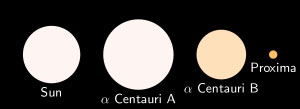 Then, 25m away, a peppercorn to represent the Earth. Then, 25m away, a peppercorn to represent the Earth.- The moon would be a pinhead, only 5 cm away from the peppercorn
- But the nearest star Proxima Centauri would be 6500 km away! (4.2 ly)
- α Centauri A/B, and Proxima Centauri; 1.1 of solar mass, 0.90, and 0.12.; Proxima Centauri is 15,000 Au (=0.24 ly) away from α Centauri AB.
- How stars work:
- A gigantic gravitational force is pulling all the stuff in the star towards the center; like a sort of slow-acting hydrogen bomb, giving out huge quantities of heat and light
- There is a balance between the outward push of the heat and the inward pull of gravity. The star acts as its own thermostat.
- Into orbit:
- aphelion and perihelion
<G. apo=far; peri=near
- gravitational slingshot effect: Cassini space probe to Saturn borrowed from the gravity and orbital movement of three planets on the way; Venus (twice), Earth, then Jupiter.
- Largest star: (from Wikipedia)
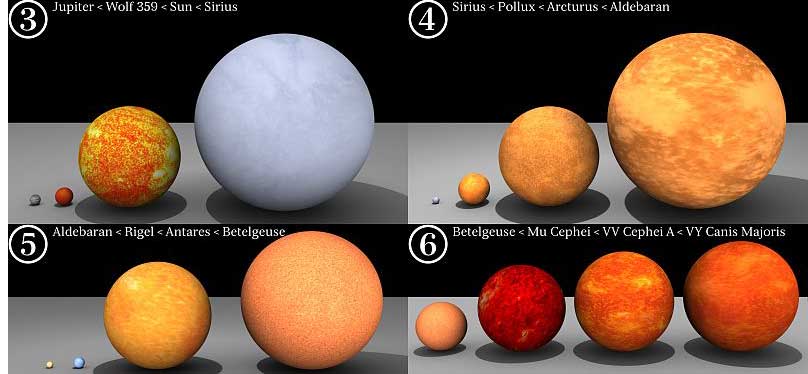
- VY Canis Majoris (Red giant); the biggest in diameter ever known
- Distance: 4000 ly; Luminous Blue Variable
- Diameter: 2000 times of Sun = 200K times of Earth
- Mass: 30 times of Sun = 9M of Earth
- Diameter of Earth = 100 times of Sun
- Mass of Earth = 300K times of Earth
- Eta Carinae and R136a1: the heaviest in mass ever known
- Distance: 7500-8000 ly
- Diameter: 240 times of Sun
- Mass: 100 times of Sun= 30M times of Earth
- Life: about 1M years old = 1/1000 of Sun
- We are stardust:
- Without occasional supernova explosions, the elements necessary for life would not exit.
- Light of our lives:
- If there is life out in the universe, it is almost certainly near a star.
If it is anything like our kind of life, at least, it will probably be on a planet about the same apparent distance from its star as we are from our sun.
- All life needs energy, and the obvious source of energy is starlight.
- You can think of a green leaf as a low, spread-out factory whose entire flat roof is one great solar panel; The end products of the factory are sugars of various kinds.
- These are then piped through the veins in the leaf to the rest of the plant, where they are used to make other things, like starch, which is a more convenient way to store energy than sugar.
|
6. 太陽とは何か:
- 古代エジプト:
- 古代エジプト人は太陽崇拝者だった。その太陽神はRa. エジプトの伝説では、天空は女神Nutの体であり、毎夜太陽を飲み込み、翌朝再び復活させた。
- 古代ギリシャやバイキングは、太陽を天空を駆ける馬車と見なした。
- ギリシャ人は、太陽神をヘリオスと呼んだ。
- その他の神話では、太陽は神ではなく、神を最初に作った者といして描いている。
- 空間の大きさ:
- 太陽をサーカー上のサッカーボールとする。
- 地球はその25m先にある胡椒の実
- 月はそこから5cm離れたピンヘッド
- 最も近い(4.2光年)プロキシマ・ケンタウリ(ケンタウルス座α星の第2伴星)は、6500kmかなたにある。
- 恒星とは:
- 巨大な重力が全ての物を中心部へ引き込む。ゆっくり燃える水素爆弾で、巨大な熱と光を発する。
- 熱による膨張力と、重力による引力の釣り合い、サーモースタットの役割
- 公転:
- 遠日点と近日点
- カッシーニ土星探査船:重力スイングバイ
- 巨大恒星:
- おおいぬ座VY星
- 距離:4000光年
- 直径:太陽の2000倍
- 質量:太陽の30倍
- りゅうこつ座イータ星
- 7500-8000光年;青色超巨星
- 直径:太陽の240倍
- 太陽質量の70倍と30倍の連星
- 我々はスターダスト:
- 時々の超新星爆発がなければ、生命にとって必須元素は存在していない。
- 生命の光:
- 宇宙に生命が存在しているとすれば、それは間違いなく恒星の近くである。我々のような生命体であれば、すくなくともその恒星から見かけの距離が我々の太陽と同じとなるような惑星上であろう。
- 全ての生命はエネルギーを必要とする。そのエネルギー源は恒星の光である。
- 緑の葉は、ソーラーパネルのようなものである。その生産物は各種の糖である。
- それは葉脈を通じて植物の他の場所に運ばれ、でんぷんなど糖よりも便利なエネルギーに貯えられる。
|
>Top 7. What is a rainbow?:
 Newton discovered: Newton discovered:
- When a beam of light travels through air and hits glass, it gets bent (refraction).
- Red light bends at a shallower angle than blue light. The blue light is going to bend further than the red light, so they will be separated from each other when they emerge from the other side of the prism. White light is really a mixture of all the different colors.
- Newton's Experimentum Crucis:
White light passed through the first prism, which spread it out into all the colors of the rainbow. The spread-out rainbow colors then passed through the second prism; having the effect of merging the rainbow colors back into white light again.
- Ultraviolet:
- Some flowers have stripes or other patterns for luring insects in to pollinate them, patterns that can only be seen in the ultraviolet range of wavelengths. Insect eyes can see them.
- For example, the evening primrose flower looks yellow to us with no pattern, no stripes. But in ultraviolet light you suddenly see a star burst of stripes.
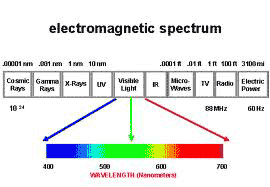 At the other end of the the spectrum, insects can't see red, but we can. At the other end of the the spectrum, insects can't see red, but we can. - Beyond red is infrared, which we can't see, although we can feel it as heat. A bee might call red 'infra-orange'. Some snakes are especially sensitive to it, using it to detect their prey.
- Radio astronomy:
- take photographs of stars using radio waves, using a radio telescope.
- We learn different things about the stars and the universe by using different parts of the spectrum. The fact that our eyes can see through only a tiny slit in the middle of the vast spectrum.
|
7. 虹とは何か:
- ニュートンの発見:
- 光が空気中を透過しガラスに当たると屈折する。
- 赤色は、青色より曲がり方が浅い。
- プリズムに当てると反対側に光が分離してスペクトラムが表れる。
- ニュートンの実験:
白色光を最初のプリズムに通して、スペクトラム分離し、それらを再度プリズムに通すと、白色に戻る。
 紫外線: 紫外線:
- 一部の花は、昆虫を引き寄せるために、紫外線でしか見えない線や模様がある
- サクラソウは、黄色で模様がないが、紫外線では、星状の模様が現れる。
- 昆虫には赤色が見えない。
- 赤色の外側は、赤外線で我々は熱としえ感じる。蜂にとっては、赤色も橙外線ということになる。一部の蛇は、赤外線に敏感で、捕食に利用している。
- 電波天文学:
- 電波望遠鏡を使って星の撮影を行う。
- 恒星や宇宙を、様々なスペクトラムの電波で撮影する。我々の目はスペクトラム、可視光という狭いスリットで物を見ている。
|
>Top
8.When and how did everything begin?
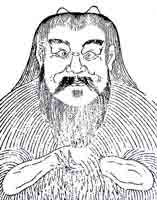 Chinese myth - Pán Goa: Chinese myth - Pán Goa:
- Pán Goa depicted as a giant hairy man with a dog's head. In the beginning there was no clear distinction between Heaven and Earth.
- Curled up inside the egg, Pan GU slept for 18,000 years. When he finally awoke he wanted to escape, so he picked up his axe and hewed his way out. Some of the contents of the egg were heavy and sank to become the Earth. Some of them were light and floated up to become the sky.
- His breath became the wind, his voice became thunder; his two eyes became the moon and the sun, his muscles farmland and his veins roads. His sweat became rain, and hi hairs became stars. Humans are descended from the fleas and lice that once lived on his body.
- Greek myth -Atlas:
- Atlas also held up the sky; statues usually show him carrying the whole Earth on his shoulders.
- Indian myth:
- Before the beginning of time there was a great dark ocean of nothingness, with a giant snake coiled up on the surface. Sleeping in the coils of the snake was Load Vishnu. Eventually Lord Vishnu was awakened by a deep humming sound from the bottom of the ocean of nothingness, and a lotus plant grew out of his navel. In the middle of the lotus flower sat Brahma, Vishnu's servant. Vishnu commanded Brahma to create the world. So Brahma did just that.
- None of the myths gives any explanation for how the creator of the universe himself came into existence.
- Modern Science: The big bang model:
- The observable universe seems to have begun in the big bang, and this remarkable event happened just under 14B years ago.
- Time itself began in the big bang, and we should no more ask what happed before the big bang than we should ask what is north of the North Pole.
- Galaxy:
The stars are still actually clustered together into groups called galaxies.
- Our sun is just one of the stars of the Milky Way.
- Re: Cosmic distance ladder:
- Parallax method:
We have the parallax method for measuring very short distance; and there is a ladder of various kinds of standard candles that we can use for measuring great distances. (up to 1000 parsec)
- 1 arcsecond for an object is 1 parsec (=3.26 ly)
- Statistical parallax method: using Dopper shift in the spectrum
- Cepheid variable:
very luminous variable stars: strong relationship between a Cepheid variable's luminosity and pulsation period, which is used as a standard candles for measuring extragalactic distance. (up to 20 parsec)
- Disk galaxy:
Tully-Fisher relation, which uses close relationship between galaxy stellar mass (luminosity) and total gravitational mass (amplitude of the rotation curve).
- Type Ia supernova explosion:
a violent explosion of a white dwarf, with having 1.38 solar masses. This category of supernova produces consistent peak luminosity because of the uniform mass of white dwarfs. These explosions are used as standard candles to measure the distance.
- Hubble's law: proportional relationship of distance and speed of moving away of galaxies from us.
|
8. すべてはいつどのように始まったのか:
- 中国神話:盤古
- 宇宙開闢の創世神。犬の頭を持つ多毛の巨人。始めは天地の区別がなかった。
- 卵の中で、盤古は18000年もの間寝ていた。目覚めて、自分の斧で卵を破り外へ出た。卵の中身の内、重いものは沈み大地となり、軽いものは浮いて天空となった。
- 彼の息は風、声は雷、両眼は、月と太陽になった。筋肉は農地に、血管は道路になった。汗は雨に、髪は星になった。人間は、彼の体に棲んでいた蚤・虱から由来する。
- ギリシャ神話:アトラス
- アトラスは天球を担っている。彫像は地球全体を担いでいる姿である。
- インド (ヒンドゥー教)の神話:
- 時間の始まる前には、空虚な暗黒の大洋があり、大蛇がとぐろを巻いてその表面にいた。そのとぐろの中にヴィシュヌ神がいた。ヴィシュヌ神は、大洋の底からの深い音の目覚め、その臍から蓮の花が生長した。その蓮の花の中にはブラフマー神 (4つの顔を4本の腕を持つ)が生まれ、ヴィシュヌ神に仕えた。ヴィシュヌは、ブラフマーに世界を創造させた。
- これらの神話のいずれも宇宙創造者のどのように存在するようになったかについてお説明はない。
- 現代科学:ビッグバン・モデル
- 観測できる宇宙はビッグバンで始まった。この画期的事件は140億年前に起こった。
- 時間自身もビッグバンで始まった。それ以前については敢えて問わない。それは北極点に立って北の方角を聞くようなものだから。
- 銀河:
恒星は群をクラスターとして銀河を構成する。
- 太陽も、我々の銀河である天の川の一つの恒星
- 宇宙距離梯子:
- 年周視差
- 非常に近くの距離は、年周視差を使って距離を測定( 1000パーセクまで)
- ケフェイド変光星
- 円盤銀河 (タリー・フィッシャー関係)
- Ia型超新星
- 白色矮星が起こす超新星爆発
太陽の1.4倍質量になると爆発、爆発時の明るさも一定
- ハッブルの法則
- ハッブル係数を決定。銀河までの距離と遠ざかる速度とは比例関係
|
>Top 9. Are we alone?:
- Is there really life on other planets?
- Nobody knows. Probably on millions of planets.
- The first thing we might ask is how many planets there are. New extra-solar planets are discovered almost every day.
- Planets are too dim to be seen at any great distance. So, we have to rely on indirect methods.
- If a star has an orbiting planet, the spectroscope will show us a rhythmically pulsating red-blue-red-blue shift patter, and the timing of these regular shifts will tell us the length of the planet's year. At the time of May, 2012, 701 planets have been detected.
- When a planet comes between us and its star, the star becomes very very slightly dimmer, and sometimes our instruments are sensitive enough to detect this dimming. So far, 230 planets have been discovered in this way.
- The present grand total is 763 planets orbiting stars in our galaxy other than the sun.
- The number of star in our galaxy is about 100B, and the number of galaxies in the universe is about the same again. That means 10,000 billion billion stars in total. 10% are described by sun-like.
- we don't know what proportion of earth-like planet. But even if the proportion is quiet low, the absolute number will still be high.
- Water is easier to detect than life itself. Some of the water has to be in liquid form.
- Recently (May 2011) a 'Goldilocks planet' was discovered orbiting a star called Gliese 581, about 20 ly away. The star is a red dwarf, much smaller than the sun. It has six planets, named Gliese 581e, b, c, g, d and f. One of them Gliese 581d is thought to be in the zone for liquid water.
- Wherever light is available, it is technically easy to use light rays to fine your way around, to navigate, to locate objects. Where light is present it is very likely that eyes will evolve because they are so useful.
|
9.
我々は孤独なのか:
- 他の惑星に生命はいるか:
- 誰もわからない。恐らく何百万もの惑星上にいるかも。
- 最初に疑問は惑星がどの程度あるか。ほとんど毎日、太陽系外惑星が発見されている。
- 遠方の惑星は暗くて見えない。間接的な方法で見つける。
- 惑星が周回する恒星は、赤方・青方偏移を繰り返す。このタイミングは惑星の周回年に相当する。2012.5段階で、701個の惑星が発見されている。
- JPLのHP(2012/10)では、確認済809個、候補2321個とある。
- 惑星が、その恒星と我々の間に来ると、恒星の光度がわずかに暗くなる。この方法で230個の惑星を発見。
- 現在までに、我々の銀河系内に計783個を発見。
- 天の川には1000億の恒星があり、銀河の数は同程度ある。従い、全恒星の数は、10000 ×10億 x 10億となる。この内の10%は太陽型の恒星。
- 地球型惑星の比率は不明。その比率が低いとしても、絶対するは大きい。
- 水は、生命よりも探査しやすい。一部の水は液体状態で存在。
- グリーゼ581は、20光年先の赤色矮星で6個を惑星を持つ。その内、4番目のGliese 581d惑星には液体の水が存在する領域にあると見られる。(Habitgable zone = Goldilock zone)
- 光が存在すれば、その光を使って移動したり対象を見つけたりするのは容易。光が存在しれば、便利なので目が進化する。
|
>Top 10. What is an earthquake?:
- In an earthquake, the whole landscape behaves like a sort of liquid. It looks like the sea, with waves passing through it.
- If you are down on the ground, you don't see the waves because you're too close to them. You just feel the ground moving and shaking beneath your feet.
- How the Earth moves:
- In 1912, Alfred Wegner suggested that the continents drifted about like gigantic ships. (Continental Drift) Africa and South America and the other great southern land masses had once been joined together.
- The modern theory of plate tectonic isn't quite the same as Wagner's idea: whole crust, including the bottom of the sea, as a complete set of interlocking plates.
- The continent don't only move away from each other. Sometimes they bump into each other, and when that happens huge mountains ranges get pushed up towards the sky; The Himalayas were formed when India collided with Asia.
- The movement of the continents happens agonizingly slowly. Somebody once said it happens about as fast as fingernails grow. But the fingernails grow at a pretty constant speed, whereas the continents move in jerks: An earthquake is what we feel when one of those jerks happens.
- Sea-floor spreading:
- The slit in the floor at the bottom of the Atlantic Ocean runs all along the deep sea floor form the far south to the far north; called mid-Atlantic ridge.
- What drives the moving belts that carry the great plates of the Earth with their cargo of continents? Deep beneath the Earth's surface there are what are called convection currents. The heat comes from deep down. The center of the Earth is very hod indeed, and it it goes on being hot until much closer to the surface. Occasionally the heat bursts out through the surface at a place we call a volcano.
- Re: Convection includes fluid movement both by bulk motion (advection) and individual particles (diffusion)
- Driven by heat:
- Convection currents follow pretty complicated paths. It's no wonder that the various plated on the Earth's surface are carried in all sorts of directions, rather than round and round.
- Sometimes a moving plate slides underneath a neighboring plate. This is called 'subduction'. Part of the African plate is being subducted under the Eurasian plate. This is one reason why there are earthquakes in Italy.
- San Andreas Fault:
Los Angels lies on the Pacific plate, not the North American plate, and is steadily creeping up on San Francisco, most of which is on the North American plate.
|
10.
地震とは何か:
- 地震では、地面全体が液体のように振る舞う。海のように波が通り過ぎる。
- 地震の時、地面に立っていても波はみえない。足下が動き揺さぶられるのである。
- 地球はどう動くか:
- 1912年、A.ウェゲナーは大陸移動説を唱えた。アフリカと南アメリカ大陸、その多の島々はかつては一つの超大陸だったと。
- 現代のプレートテクトニックス理論は、ウェゲナーの理論と同じではない。近く全体が、一体となって動く。
- 大陸は互いに離れるだけでなく、時々、衝突し、造山運動を起こす。ヒマラヤ山脈は、インド亜大陸がアジア大陸に衝突することで形成された。
- 大陸の動きは極めて遅い。(100mm/y以下)これは爪の伸びる速度(40mm/y)に近い。但し、爪の伸びは、殆ど一定だが、大陸移動は突如として起こる。その時地震が発生する。
- 海底の拡張:
- 大西洋の中央を南北に貫く裂け目、中央海嶺。(平均25mm/y)
- この動きの原因は、地球の地下深くにある対流移動による。その熱は、地球中心部分から来る。その時、火山活動を伴う。
- Advection (移流)とdiffusion (拡散)
- 熱移動:
- 対流による動きは複雑。単純な回転ではなく、あらゆる方向へのさまざまな移動を伴う。
- 隣接するプレートに下への沈み込みが起こる。アフリカプレートの一部はユーラシアプレートの下に沈み込む際に、イタリーに地震が発生する。
- サンアンドレアス断層: ロスアンジェレスは太平洋プレート上にあり、北アメリカプレート上にあるサンフランシスコの上に乗り上げつつある。
|
>Top 11. Why do bad things happen?:
- Murphy's Law, or Sod's Law:
this states; 'If you drop a piece of toast and marmalade on the floor, it always lands marmalade side down. or 'If a thing can go wrong, it will.'
- Luck, chance and cause:
- Everything happens for a reason.; which is to say that events have causes, and the cause always comes before the event.
- 'Reason means 'past cause', but people sometimes use reason in a very different sense, to mean something like 'purpose'.
- Pollyanna and paranoia:
- The universe has no mind, no feelings and no personality, so it doesn't do things in order to either hurt or please you. Bad things happen because things happen. Whether they are bad or good from our point of view doesn't influence how likely it is that they will happen.
- Earthquakes ad hurricanes are bad for their victims, but they don't take active steps to do bad things; they just happen.
- Natural selection, the struggle for existence means that every living creature has enemies that are working hard for its downfall.
- The world is full of dangerous predators and it is safest to assume that something a bit like Sod's Law is true.
- Immune system:
- The immune system needlessly, wastefully and even damagingly fighting harmless things. For example, pollen in the air is normally harmless, but the immune system of some people overreacts to it.
- Allergies can sometimes be very dangerous. A few people are so allergic to peanuts that eating a singe one can kill them.
- Cancer:
- A cancer is a group of our own cells that have broken away from doing what they are supposed to do in the body. They are our own cells slightly modified. This means the immune system has a hard time recognizing them as foreign.
- It is much easier to kill bacteria, because bacterial cells are different from ours. Chemotherapy poisons cancer cells, but it also poisons our healthy cells because they are so similar.
- The immune system sometimes goes too far and attacks harmless tissues, attack the body's own cells - and we call this an autoimmune disease.
- Could it be that the explanation of autoimmune diseases is that they are evidence of evolution's work-in-progress on an effective weapon against cancer?
|
11.
なぜ悪いことが起こるのか:
- マーフィーの法則あるいはソッドの法則:
ママレードを塗ったパンを床に落とすと、いつもママレードの側が下になる。悪いことが起こり得る時は、いつもそうなる。
- 運、機会、原因:
- 全ての出来事には理由がある。つまり出来事には原因があり、原因は出来事の前に存在する。
- 理由とは過去の原因のことだが、人はよく理由のことを目的と勘違いする。
- 楽天家か被害妄想か:
- 宇宙には、精神や感情や人格は存在しない。従って出来事は誰も傷つけたり喜ばしたりはしない。悪いことが起こるのが、それが起こっただけのことである。我々とって良いか悪いかは、出来事の確率に影響しない。
- 地震や台風は我々にとっては被害だが、自然は悪さをしようとしているのではなく、単に発生しているだけである。
- 自然淘汰、つまり生存競争とはすべての生き物にとっては、それを滅ぼそうとする敵がいることを意味する。
- 免疫システム:
- 免疫システムは、必要性も意味もなく無害なものを攻撃することがある。空気中の花粉は通常は無害だが、一部の人々の免疫システムはそれに過剰反応する。
- アレルギーは時に非常に危険になる。ピーナツにアレルギーのあるごく一部の人にとっては、それを一粒食べたことで死に至る場合がある。
- 癌:
- 癌は、本来の機能が破壊された我々自身の細胞の一部である。細胞がごく一部変形しただけであり、これは免疫システムにとって異物と見分けられない。
- 細菌を殺すのは容易である。細菌の細胞は我々とは異物だからである。化学治療でも癌細胞は殺せるが、同時に我々の健康な細胞も傷つけてしまう。
- 免疫システムは時として過剰となり、我々自身の細胞組織を攻撃してしまうことがある。これを自己免疫疾患という
- 自己免疫疾患があることは、癌に対する有効な武器を得るための進化途中を意味するのだろうか。
|
>Top 12. What is a miracle?
- Miracles, magic and myths:
- They can be fun. I hope you agree that the truth has a magic of its own. The truth is more magical - in the best and most exciting sense of the word - than any myth or made-up mystery or miracle. Science has its own magic; the magic of reality.
|
12.
奇跡とは何か:
- 奇跡・魔法・神話:
- それはおもしろい。真実にはそれ自体が魔法の要素があることに納得してもらえると思う。sれはどんな神話は作られたミステリーや奇跡よりもである。科学それ自体が魔法なのである。真実という魔法である。
|
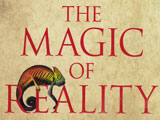
 Then, 25m away, a peppercorn to represent the Earth.
Then, 25m away, a peppercorn to represent the Earth.
 Newton discovered:
Newton discovered:
 At the other end of the the spectrum, insects can't see red, but we can.
At the other end of the the spectrum, insects can't see red, but we can.  紫外線:
紫外線:  Chinese myth - Pán Goa:
Chinese myth - Pán Goa: